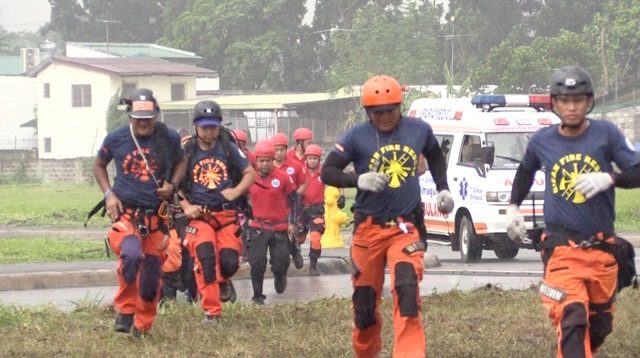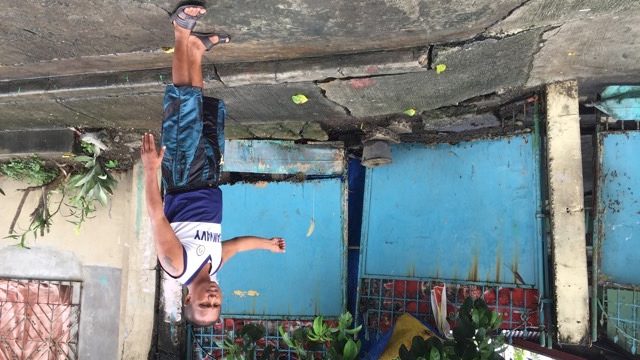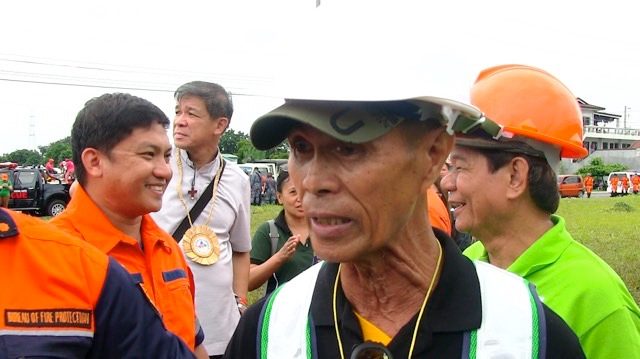SUMMARY
This is AI generated summarization, which may have errors. For context, always refer to the full article.

BINAN CITY, Philippines – Loud sirens signaled the start of the 3rd Quarter #Pagyanig Nationwide Simultaneous Earthquake Drill (NSED) at 9 am on Wednesday, September 28, in various parts of the country. This was followed immediately by a series of well-orchestrated disaster response scenes to rival any Hollywood disaster movie.
At the staging area – a vacant subdivision in Biñan, Laguna, some 43 kilometers from Metro Manila – more than 100 people did the duck, cover, and hold technique. Residents from barangay San Francisco evacuated their homes and moved to a nearby open field. Simultaneously, the barangay and local government set up a command post to receive reports and assign responders, who kept arriving on site.
From evacuating sick patients to putting out fires, each response team carried out their assignment with utmost seriousness, even if this was only a drill.
There is no time for jokes. When the real quake hits, they say, things will be much worse.
Ominous
The scenario they’re preparing for is a grim one.
Based on the Metro Manila Earthquake Impact Reduction Study (MMEIRS), a 7.2 magnitude quake caused by a movement of the West Valley Fault (WVF) would cause massive damage in Metro Manila and neighboring cities and towns. The study estimates that 35,000 people could die in Metro Manila alone, with hundreds of thousands more injured. In Biñan, where the fault line crosses, some 3,000 people could die. (READ: INFOGRAPHIC: How powerful is a magnitude 7.2 earthquake)
According to the Office of Civil Defense (OCD), the villages in Juana Complex of Barangay San Francisco are one the most vulnerable communities in Region 4A (CALABARZON). Residents are aware of what could happen to them should an earthquake strike. They see signs of the fault line in the cracks on the road and on their walls.

Samuel Trinidad, 49, has been a resident of Juana Villages since 1994. Over the past two decades, he has seen how the fault line has slowly shifted the earth beneath his home. He points out cracks in the cement where the earth has parted and uneven roads. (READ:12-point checklist for an earthquake-resistant house)
When residents first moved into the village, they were unaware they lived atop a fault line. Today, they say they are prepared to evacuate, but won’t leave their homes.
“Nakakatakot siyempre. Pero matagal na kami nakatira dito at wala nang malipatan,” said Trinidad. (I’m afraid of an earthquake. But we have lived her a long time and have no where else to go.)
Barangay San Francisco residents have organized themselves and carried out many earthquake drills in the past. The OCD says the residents are excellent examples of how communities at the grass-roots level should prepare for disasters. (READ: Preparing your family for an earthquake)
“Dito sa amin, nakagawa na kami ng several earthquake drills. Ako’y natutuwa na ‘di naming naasahan na darating sa punto na national level na, oh my God! Level up na,” said retired colonel Marciano Espique who is the barangay’s disaster coordinator and incident commander.
(Our barangay was able to run several earthquake drills. I’m happy because we never expected to reach this point where we are part of a national drill, oh my God! We have leveled up.)
During the drill, Espique was the first on the scene, mobilizing responders and assessing the damage from field reports.

Setting the bar
Many more drills led by LGUs and government agencies were held simultaneously in other parts of the country. Netizens posted videos and photos of themselves doing duck, cover, and hold on social media and on the Agos Alert Map. (Know more about Agos, powered by eBayanihan)
Regional incident management team arrives in Juana Village in Biñan, Laguna. #Pagyanig #NSED via @PIAdesk pic.twitter.com/fH0ALtv13F
— MovePH (@MovePH) September 28, 2016
NH: Nationwide Simultaneous Earthquake Drill at DepEd Central Office #Pagyanig pic.twitter.com/bhQ22wjCLd
— DepEd (@DepEd_PH) September 28, 2016
A roll call of employee must be done to ensure that no one is left inside the bldg
— DILG MIMAROPA (@dilgmimaropa) September 28, 2016
DILG MIMAROPA Regional Office Earthquake Drill #pagyanig pic.twitter.com/m7pn7i3yQd
Police Officers conducts proper apprehension of looter during the drill. #Pagyanig pic.twitter.com/Y8MF4rls7D
— Phres Evardone (@PhresEvardone) September 28, 2016
At the top of the hill, students of Butag NHS in Sorsogon participated in the simultaneous earthquake drill. #Pagyanig @DepEd_PH pic.twitter.com/yhNwF0fIKH
— Eugene Chris (@SirEugeneChris) September 28, 2016
What to do before and during an earthquake? #Pagyanig pic.twitter.com/Bjd01EY5a7
— DSWD Region VII (@dswdfo7) September 28, 2016
It took residents, disaster responders, and the government more than two weeks of planning and rehearsing for the ceremonial earthquake drill.
Top government officials present in Biñan expressed their satisfaction at the execution of the drill and the performances of the responders.
“In all the earthquake drills I’ve attended, this ranks in the top 3,” said Department of National Defense (DND) Undersecretary Eduardo del Rosario, also a former executive director of the National Risk Reduction and Management Council (NDRRMC).
NDRRMC Executive Director Ricardo Jalad vowed to continue the quarterly quake drill, noting that drills will also be conducted in various regions.
OCD Region 4A regional director Vicente Tomazar acknowledges there’s always room for more improvement, such as improving communication and coordination among all stakeholders.
Until the real quake strikes, he adds, all that’s left to do is prepare and hope for the best. – Rappler.com
Want to know how to prepare for a major earthquake? Here’s a page where you can watch videos, read guides, and learn more about quakes.
Add a comment
How does this make you feel?
There are no comments yet. Add your comment to start the conversation.